
9464
.pdf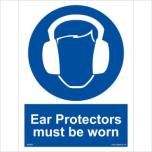
between the source and the worker, or increase the distance between the worker and the source. (However, this can be difficult in many cases.)
C. At the worker
Controlling noise at the worker, by using ear protection (sometimes called hearing protection) is, unfortunately, the most common yet least effective form of noise control. Forcing the worker to adapt to the workplace is always the least desirable form of protection from any hazard. Generally there are two types of ear protection: earplugs and earmuffs. Both are designed to prevent excessive noise from reaching the inner ear.
Earplugs are the least desirable type of hearing protection because they do not provide very effective protection against noise and they can cause ear infection if pieces of the plug are left in the ear or if a dirty plug is used.
Problem I
Company XYZ is a manufacturer with five power presses producing noise levels of 102 - 104 dB. Even when only one or two presses are operating, the noise levels are still as high as 98 dB. This is painful for the workers and puts them in serious danger of losing their hearing. What solutions to this problem can you suggest?
Problem II
Company ABC produces nails. The machines that cut the nails produce a noise level of 95 dB. These machines are all in a row in one section of the factory and need to be operated by a worker for eight hours a day. All workers have been

given ear protectors but they do not wear them because it is too hot and uncomfortable. What solutions to this problem can you suggest?
Task
You are safety instructors. Meet to find solutions.
1.Work in pairs. Suggest actions of noise control in each case.
2.Meet as one group and present your ideas.
3.As one group, agree on a final solution.
Useful phrases
Why don’t we…?
I think we should…
It might be better if we…
I suggest we…
Writing
As the safety instructor, write a memo to the Health and Safety Officer about the actions agreed on in the meeting.
→(see Appendix I)
UNIT III
POOR LIGHTING
Starting up
A.What do you think makes lighting poor? What can poor lighting cause?
B.Read the article from the site
http://www.mflohc.mb.ca/fact_sheets_folder/lighting.html and see if you were right.
“Bad lighting” is lighting that is inappropriate for the tasks being performed.
The level of illumination may be too low or too high, excessive direct or reflected glare may be present, the color rendering of artificial light sources may be inadequate, or the distribution of light may be inappropriate.
Poor lighting has been associated with a variety of problems including low productivity, high human error rates, eye strain, headache, a reduction in mental alertness, general malaise, and low employee morale. Each of these problems can have a significant negative economic impact on any organization. Poor lighting may also cause employees to assume awkward body postures, which may contribute to the development of cumulative trauma disorders (CTDs) such as carpal tunnel syndrome.
C. Do you think poor classroom lighting affects students’ performance? Why?
How do you find the existing lighting systems in the university classrooms? Do they need improving or modifying?
Vocabulary
A. Match elements of lighting to their definitions.
1. Luminance
2. Colour
3. Glare
4. Reflectance
5. Contrast
6. Illuminance
B. Read the text from the site http://www.ccohs.ca/oshanswers/ergonomics/lighting_survey.html and fill in the gaps with the words from task A.
What Are the Elements of Lighting?
General lighting provides light for an entire building or facility.
Task lighting, on the other hand, is the lighting available at the work area where a task is performed. Proper task lighting makes work safer and easier.
Workers receive about 85 percent of their information through their eyes. Appropriate lighting highlights moving machinery and other safety hazards. That helps prevent accidents from unseen hazards. Good lighting also reduces vision problems and injuries from momentary blindness.
Quantity of Light:
The level of quantity of light falling on a surface is called ………. More light is needed for fast paced fine detailed work with low contrast, such as rapid reading of small letters in pencil, than for rough assembly work.
Quality of Light:
There are several elements of light quality that must also be accounted for when determining the proper lighting for a work station or work environment. These include colour, contrast, glare, luminance and reflectance
……….is the amount of light reflected or coming from a light source or surface. It is important that there is not a great difference between the luminance levels for the task and that of the surrounding area.
………. is the percentage of light falling on a surface that is reflected. In an office the most reflective surface should be the ceiling; the least reflective should be the floor and in between are the reflectance of walls and furniture.
……..is the relationship between the light coming from an object and the immediate background, such as words on paper. High contrast is important for fine detail work.
……..occurs when there is too much direct or reflected light within the field of view. Glare causes a decrease in contrast which results in decreased visibility and physical discomfort.
……… can affect both the mood and the perception of size in a workplace.
Blues and greens are considered relaxing or soothing.
Orange, yellow and brown colours are thought to be stimulating. Red and violet are considered alarming or aggressive.
Pastel colours reduce the impact of colour.
Cool colours such as blues and greens can make a space seem larger.
Reds and oranges can make a space seem smaller. Different types of lights will influence how colours are perceived.
C. Read the text again carefully and present its main ideas in the form of a diagramm.
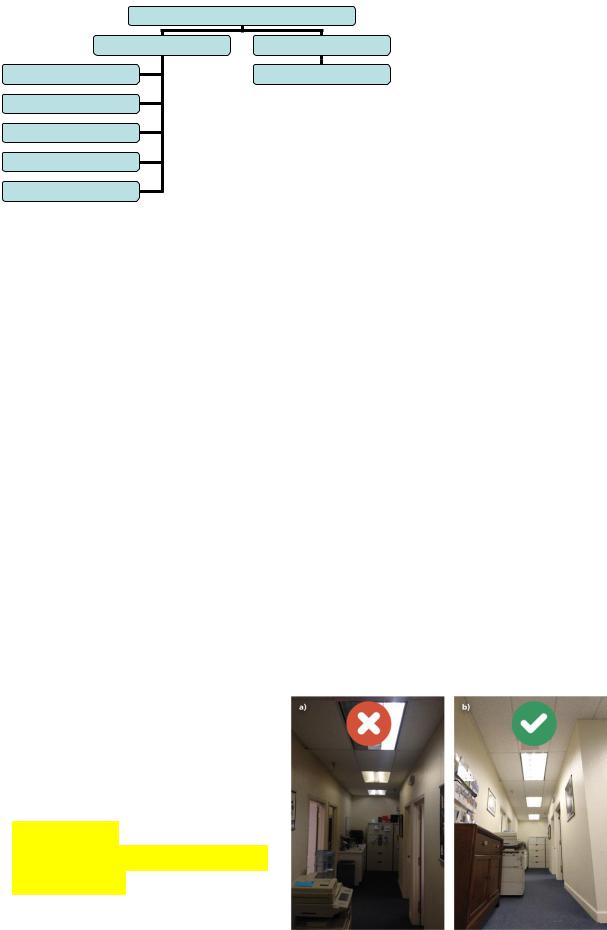
Elements of lighting
Pronunciation
A. Match the words in the left and right columns which contain the same sound.
1. |
lux |
|
a. accident |
2. |
appropriate |
|
b. morale |
3. |
inadequate |
|
c. illuminance |
4. |
fluorescent |
|
d. comfortable |
5. |
contrast |
|
e. cause |
6. |
soothing |
|
f. control |
7. |
fatigue |
→ |
g. sufficient |
Reading
A. Before reading, match the verbs and nouns from the text to make word partnerships about poor lighting.
1. |
to lead |
a. glare levels |
2. |
to draw attention to |
b. dreary environment |
3. |
to prevent |
c. lighting systems |
4. |
to maintain |
d. costly errors |
5. |
to create |
e. hazardous operations |
6. |
to improve |
f. to visual fatigue |
7. |
to control |
g. productivity and efficiency |
B. Read the article from the site http://www.iapa.ca/Main/documents /pdf/lightin.pdf and match the subheadings with the following paragraphs.
*area to be lit
*the benefits of proper lighting *human factor
Lighting at Work

1.----------------------
Proper workplace lighting is essential to any good business:
*it allows employees to comfortably see what they’re doing, without straining their eyes or their bodies;
*it makes work easier and more productive;
*it draws attention to hazardous operations and equipment; *it helps prevent costly errors and accidents.
Proper lighting is also required under s.21 of the Industrial Establishments Regulation. There must be sufficient light in the workplace to ensure the safety of every worker.
To realize the benefits of proper lighting, it is important to maintain your lighting systems and train your workers in how to use them.
2.---------------------
The lighting in your workplace should enable employees to comfortably see what they need to do their tasks. Poor lighting makes it hard for employees to see and can lead to
visual fatigue and discomfort. It can also lead to neck and back pain, if the worker adopts a poor posture. Insufficient lighting also creates a dreary environment. Proper lighting, on the other hand, creates a pleasant atmosphere and gives workers a sense of well-being. This improves their productivity and efficiency.
Lighting levels should meet the needs of older workers and workers with visual limitations. To compensate for this loss, increase the lighting to a comfortable level. One way to do this is by providing lighting with adjustable intensity.
Older workers also take longer to adapt to changes in light intensity and are more sensitive to glare. To reduce these problems, control light and glare levels.
3.-----------------
The speed and accuracy of processing visual information are best when there is enough light for workers to do their tasks comfortably and efficiently.
Consider the size and shape of the work area and how it is used. Barriers such as furniture and partitions can block general lighting. Inappropriate lighting, such as using only overhead lights, can create shadows. Shadows can make work difficult and even dangerous by hiding sharp edges and other potential or actual hazards. To reduce shadows, provide light from various sources and directions.
C. Complete the chart with the right words: receiving and packing, loading into trucks, difficult assembly.
Recommended lighting levels by task and area

|
|
Recommended |
Task / Area |
|
Range of |
|
|
Illuminance (Lux*) |
Simple visual tasks |
|
30-100 |
●● lobby area |
|
|
●● washrooms |
|
|
●●------------------ |
|
|
Medium visual tasks |
|
300-1,000 |
●● bookkeeping |
|
|
●● filing |
|
|
●● ----------------- |
|
|
More visually demanding tasks |
|
3,000-10,000 |
●● colour inspection |
|
|
●● -------------------- |
|
|
●● proofreading |
|
|
●● fine bench or machine work |
|
|
|
(Adapted from Industrial Lighting, ANSI/IESNA |
|
|
|
RP-7-2001) |
________________________________________________________________
Lux* is the unit of measurement for illuminance.
C.Read the text again and say if the following statements are true or false.
1.Proper lighting allows employers to control employees’ work.
2.Proper lighting stops from costly errors.
3.Older people are less sensitive to glare.
4.Glare and colour can block general lighting.
Speaking
The importance of an appropriate visual environment for learning tasks also deserves careful consideration. Do you think if there is anything wrong about lighting in our department of foreign languages? What can be done about it? Work in pairs and then report your suggestions to the rest of the class.
Case study on poor lighting
The Client:
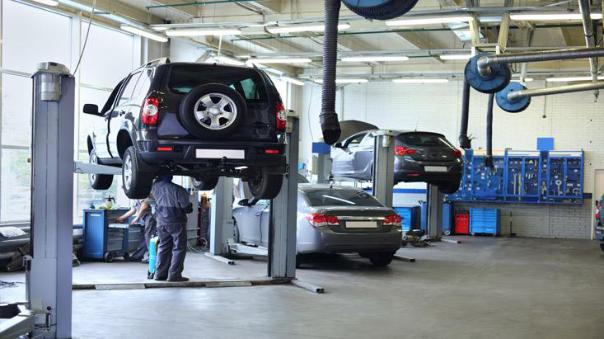
Commercial Vehicle Bodyworks, Wokingham, Berkshire
Background:
Litenow were called to advise on the replacement of the existing lighting system. The vehicle workshop is used for the repair of accident-damaged commercial vehicles and several engineers work on a variety of large vehicles.
The existing 8ft fluorescent light fittings were old, many were defective and the light output in the workshop area was very poor. Engineers were finding it difficult to work in, or under the vehicles they were repairing.
Existing Lighting:
-22 x 125 Watt twin fluorescent light fittings
-Lamp Life: 10,000 hours
-Total energy consumption: 6.82kW (allowing for control gear losses)
The Problem:
The light fittings were mounted on lighting trunking at approximately 5.5 metres from floor level.
Rotating electrical equipment used within the workshop area could give rise to stroboscopic effect with fluorescent lighting.
Phasing out of 8ft T12 lamps in near future.
Low lighting levels requiring engineers to work in imperfect conditions.
Proposed Lighting:
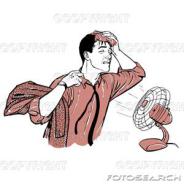
-14 x 400 Watt Metal Halide low bay fittings
-Lamp Life: 15,000 Hours
-Total energy consumption: 5.6kW (allowing for control gear losses)
Task
You are safety instructors. Meet to find solutions.
1.Work in pairs. Suggest actions of proper lighting.
2.Meet as one group and present your ideas.
3.As one group, agree on a final solution.
Useful phrases |
|
Why don’t we…? |
|
|
I think we should… |
|
It might be better if we… |
|
I suggest we… |
The Solution: (see Appendix I)
Writing
As the safety instructor, write a memo to the Health and Safety Officer about the actions agreed on in the meeting.
UNIT IV
THERMAL COMFORT
Starting up
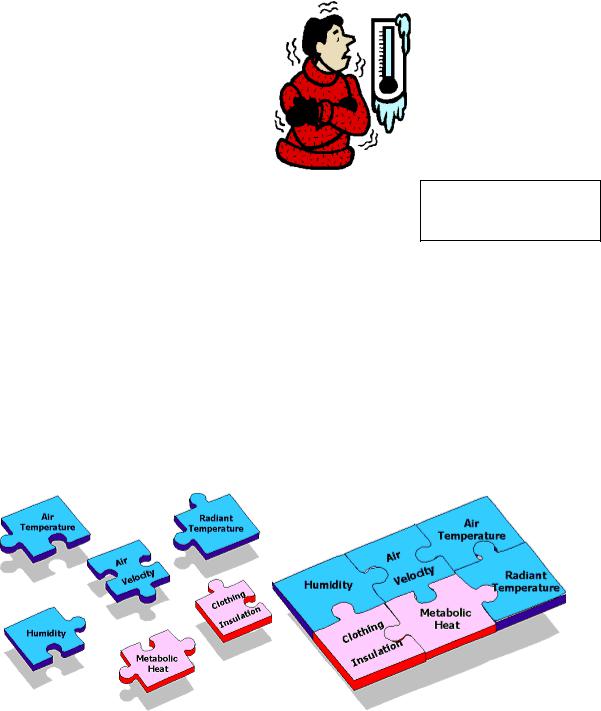
Temperature preferences vary greatly among individuals and there is no one temperature that can satisfy everyone. What temperature do you feel comfortable by? What factors does it depend on? In what way does it influence you, when you’re hot or cold?
Workers begin worrying about how to get warm again.
Vocabulary
The six factors affecting thermal comfort are both environmental and personal. These factors may be independent of each other, but together contribute to a worker’s thermal comfort.
Environmental factors: |
Personal factors: |
||
|
Air temperature |
• |
Clothing Insulation |
|
Radiant tempertaure |
• |
Metabolic heat |
Air velocity
Humidity
A. Match the words with their definitions:
1. air temperature |
a. the speed of air moving across the worker |
2. radiant temperature |
b. reduction of the transmission of heat to or |
|
from the body by surrounding clothes or per- |
